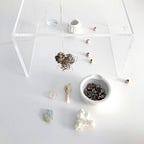Lost in Fiber: Musings from an Environmental Fiber Artist
[ republished/revised from Nau’s Thought Kitchen Journal | 2013 ]
Performance fabrics and natural fiber have had a long love affair. The earliest Paleolithic string skirts were essentially mini-aprons with seductive fringes of twined fiber strands that served as performative fashion. We now rely on a range of engineered and/or natural fibers to keep us ventilated and insulated when venturing out for work or play.
This is why I chose fiber as an art medium and vehicle for expression. Even though I had previously worked in documentary film and explored traditional art mediums, I ultimately opted to work with fiber because of its versatile and low impact/non-toxic properties. As an environmental artist, I typically use strands of spun, knotted, or twined fiber to ‘draw’ on the land for site-specific installations that are then carefully deconstructed after documentation.
Fiber has universal properties that connect us to cultures and regions in ways that are inherently border-defying. My dialogue with artisans/designers in Bulgaria, Chile, Iran, Peru, and Turkey, to name a few locales, has been inherently rich and complex because of unique connections to place and the sharing of regional knowledge. The historic transport of textiles and design of indigenous shelters in these regions often inspires ideas for nomadic and adaptable thinking — solutions that work seamlessly with the environment and the challenges of climate.
In addition to a deeper scrutiny of materials, the study of product life cycles and waste reduction strategies are vitally important for better understanding the resourceful flow of materials around us. I have spent years creating ad-hoc sculptural forms out of household fiber, recycled detritus from my daily life, as well as flotsam findings from city streets. I view these objects as diaries and tactile records of time, place, and sustainability research.
Urban environments are not devoid of intimate interactions with nature. I am sensitive to working in a manner that is adaptive, even in the most neglected pockets of a neighborhood park or vacant lot. Outreach efforts that introduce city dwellers to community gardens, natural dye plots, and local grassroots solutions are often facilitated by activities linked to plant cultivation, fiber preparation, and even the examination of clothing and textile consumption.
I am optimistic about how and why fiber will continue to play a vital role in our lives. It is important for me to help others to see why clothing and even the most frayed strands of our existence might link us directly to an exploited garment worker or a farmer toiling to produce local goods at a competitive price. I am searching for these cast-off finds or frayed fibers in the rope in order to make repairs and gain strength as our collective journey unfolds.
